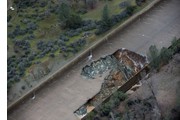Question of the Day: How complacent have California dam operators become under the ‘permanent drought’ of global warming?
found on the Interwebs
This is a story of bad reporting, bad management, and bad boondoggles.
Damage to the spillway keeps worsening at America’s tallest dam at Oroville, California. Dam operators opened the flood gates to keep the state’s second-largest reservoir from overflowing even more disastrously although they know that increasing the flow would erode a big part — perhaps the entire bottom half — of the spillway. That’s about “150 yards of concrete,” the San Francisco Chronicle reported February 10, “that will have to be painstakingly rebuilt during the dry months.” Repair costs, “state officials said, will likely top $100 million.”
Wait. What? 666 THOUSAND DOLLARS A YARD???
 Lake Oroville was at 99% capacity by Friday with only 3.5 feet left to fill. The good news is that the larger spillway, made of reinforced concrete, was peeling downward and not threatening the integrity of the 770-foot-high dam itself.
Lake Oroville was at 99% capacity by Friday with only 3.5 feet left to fill. The good news is that the larger spillway, made of reinforced concrete, was peeling downward and not threatening the integrity of the 770-foot-high dam itself.
Wait. What good news? 666 THOUSAND DOLLARS A YARD??? That’s even more than a Florida highway boondoggle!
“And Californians think they should run the country…” Rufus said.
That has to be stupid reporting. I reckon the hole is actually 150 yards long, not 150 cubic yards. Still, the equivalent of less than a tenth of a mile of Interstate highway repair (that’s about what we’re talking about here) ought not cost $100 million.
“What did they piss away on the 18-mile stretch?” Rufus asked.
Good question. The Florida Department of Transportation is famous here in the Keys for its decade-long, costly boondoggles.
The Stretch was a two-lane highway identified as U.S. 1. It carries 99% of the traffic between Florida City on the mainland and Key Largo and points west, all of it along the former right-of-way of the Key West leg of the Florida East Coast Railway. It was rebuilt to save lives and to facilitate the increased volume of traffic, particularly during hurricane evacuations.
It is now a two-lane highway divided by a concrete barrier that separates northbound and southbound lanes.
Construction took place in three stages which tied up the main entry to the Keys for years. The first ten miles, down at this end of the road, chewed us up from Key Largo to about mile marker 116. That cost $153,565,133. The second phase extended from mile marker 116 up to Florida City but the D.O.T. skipped a three-mile segment in the middle. No one knows why. Those five miles of paving took about three years, from 2008-2011 and cost $111,827,749. The middle three miles, from mile marker 121 to mile marker 124, was later in 2011 at a cost of $17,043,687. The “additional engineering and administrative costs” brought the total cost to $330 million for the entire project or more than $18.3 million per mile.
In the real world, a new six-lane Interstate highway costs about $7 million per mile in rural areas or $11-12 million per mile in urban areas.
Back to Oroville. That’s in California which is apparently even more expensive than Florida.
The Butte County sheriff issued evacuation orders yesterday for everyone living below the dam, some 188,000 people, because the crumbling emergency spillway could give way and unleash floodwaters onto rural communities along the Feather River.
Wait. What?
Didn’t they tell us the spillway was peeling downward and not threatening the integrity of the 770-foot-high dam itself?
The California Department of Water Resources said on Twitter at about 4:30 p.m. PST that the spillway next to the dam was “predicted to fail within the next hour.”
Wait. What?
Didn’t they tell us the spillway was peeling downward and not threatening the integrity of the 770-foot-high dam itself?
The damaged spillway remained standing several hours later; it’s still there.
There’s no word when evacuation order will be lifted.
“I figure the 188,000 people in Oroville, Yuba County, Butte County, Marysville and nearby communities probably voted for Trump,” Rufus said.
The water level has now dropped. The dam itself is fine.
